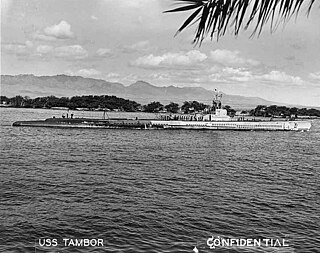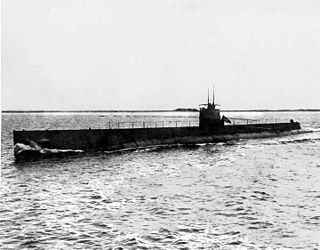
The Balao class was a design of United States Navy submarine used during World War II, and with 120 boats completed, the largest class of submarines in the United States Navy. An improvement on the earlier Gato class, the boats had slight internal differences. The most significant improvement was the use of thicker, higher yield strength steel in the pressure hull skins and frames, which increased their test depth to 400 feet (120 m). Tang actually achieved a depth of 612 ft (187 m) during a test dive, and exceeded that test depth when taking on water in the forward torpedo room while evading a destroyer.

The V-boats were a group of nine United States Navy submarines built between World War I and World War II from 1921 to 1934 under authorization as the "fleet boat" program.

The Tambor-class submarine was a United States Navy submarine design, used primarily during World War II. They were the USN's first fully successful fleet submarine, and began the war close to the fighting. Six of the class were in Hawaiian waters or the Central Pacific on 7 December 1941, with Tautog at Pearl Harbor during the attack. They went on to see hard service; seven of the twelve boats in the class were sunk before the survivors were withdrawn from front-line service in early 1945; this was the highest percentage lost of any US submarine class. Tautog was credited with sinking 26 ships, the largest number of ships sunk by a US submarine in World War II. The Tambors attained the top speed of 21 knots (39 km/h) and range of 11,000 nautical miles (20,000 km) of the preceding Sargo class, and improvements included six bow torpedo tubes, a more reliable full diesel-electric propulsion plant, and improved combat efficiency with key personnel and equipment relocated to the conning tower. In some references, the Tambors are called the "T Class", and SS-206 through SS-211 are sometimes called the "Gar class".

The Clemson class was a series of 156 destroyers which served with the United States Navy from after World War I through World War II.

The Wickes-class destroyers were a class of 111 destroyers built by the United States Navy in 1917–19. Together with the six preceding Caldwell-class and following 156 subsequent Clemson-class destroyers, they were grouped as the "flush-deck" or "four-stack" type. Only a few were completed in time to serve in World War I, including USS Wickes, the lead ship of the class.

The AA-1 class was a class of three experimental submarines of the United States Navy, built toward the end of World War I, between 1916 and 1920, intended to produce a high-speed fleet submarine. The design was not a success and the submarines saw only limited active service. However, the lessons learned were applied to the design of the later V-boats. The class was later renamed as the T-class.

The Mackensen class was the last class of battlecruisers to be built by Germany in World War I. The design initially called for seven ships, but three of them were redesigned as the Ersatz Yorck class. Of the four ships of the Mackensen class, Mackensen, Graf Spee, and Prinz Eitel Friedrich were launched, and Fürst Bismarck was not—but none were completed, after wartime shipbuilding priorities were redirected towards U-boats—and the ships were broken up in the early 1920s. The lead ship of the class was named for August von Mackensen, a prominent military commander during the war. In response to the Mackensen-class ships, the British Royal Navy laid down the Admiral-class battlecruisers, all but one of which would eventually be cancelled; the sole survivor, HMS Hood, was completed after the end of the war.

The United States' S-class submarines, often simply called S-boats, were the first class of submarines with a significant number built to United States Navy designs. They made up the bulk of the USN submarine service in the interwar years and could be found in every theater of operations. While not considered fleet submarines, they were the first submarines in the USN designed for open ocean, blue water operations. All previous submarines had been intended for harbor or coastal defense. These boats were intended to have greater speed and range than previous classes, with improved habitability and greater armament.

USS Borie (DD-215) was a Clemson-class destroyer in the United States Navy during World War II. She was the first ship named for Ulysses S. Grant's Secretary of the Navy, Adolph E. Borie. She served in the Black Sea, the Asiatic Fleet and the Caribbean between the wars, and in the Battle of the Atlantic, the long campaign to protect Allied shipping from German U-boats during World War II. As part of the antisubmarine Hunter-killer Group unit Task Group 21.14, the crew earned a Presidential Unit Citation for its "extraordinary performance." Borie also earned distinction in her final battle with U-405 in November 1943, exchanging small arms fire with and ramming the surfaced U-boat, although she was crippled during the engagement and thereafter scuttled by friendly ships.

The R-class submarines were a class of United States Navy coastal-defense submarines active from 1918 until 1945. With the first of the class laid down following the American entry into World War I, they were built rapidly. Although R-15 through R-20 were completed July–October 1918, they did not serve overseas, and the bulk of the class were not completed until after the Armistice. As had been the usual practice in several of the preceding classes, design and construction of the 27 boats of this class was split between the Electric Boat Company and the Lake Torpedo Boat Company. Both designs were built to the same military operational specifications, but differed considerably in design and detail specifics.

The 3-inch/50-caliber gun in United States naval gun terminology indicates the gun fired a projectile 3 inches (76 mm) in diameter, and the barrel was 50 calibers long. Different guns of this caliber were used by the U.S. Navy and U.S. Coast Guard from 1900 through to 1990 on a variety of combatant and transport ship classes.

The QF 3-pounder Hotchkiss or in French use Canon Hotchkiss à tir rapide de 47 mm were a family of long-lived light 47 mm naval guns introduced in 1886 to defend against new, small and fast vessels such as torpedo boats and later submarines. There were many variants produced, often under license which ranged in length from 32 to 50 calibers but 40 caliber was the most common version. They were widely used by the navies of a number of nations and often used by both sides in a conflict. They were also used ashore as coastal defense guns and later as an anti-aircraft gun, whether on improvised or specialized HA/LA mounts.

The 4″/50-caliber gun was the standard low-angle, quick-firing gun for United States, first appearing on the monitor Arkansas and then used on "Flush Deck" destroyers through World War I and the 1920s. It was also the standard deck gun on S-class submarines, and was used to rearm numerous submarines built with 3-inch (76 mm) guns early in World War II. United States naval gun terminology indicates the gun fired a projectile 4 inches in diameter, and the barrel was 50 caliber. 4x50 meant that the barrel was 200 inches long, or 16 feet long.

Convoy SC 94 was the 94th of the numbered series of World War II Slow Convoys of merchant ships from Sydney, Cape Breton Island, Nova Scotia, to Liverpool. The ships departed Sydney on 31 July 1942 and were met by Mid-Ocean Escort Force Group C-1.
The Imperial Japanese Navy Technical Department was the externally operating division of the Ministry of the Navy of Japan responsible for the administration of naval vessel construction. From 1923 onward, it took on the role of a research institution for the research and development of naval technologies and engineering. This included studying and investigating existing western naval technology, developing and overseeing Japan's domestic shipbuilding and arms industries, and training officers to become naval engineers and inspectors. The bureau was dismantled along with the naval ministry in November 1945 after Japan surrendered to the Allies at the end of World War II.

12 cm/45 3rd Year Type naval gun was a Japanese naval gun and coast defense gun used on destroyers, and torpedo boats of the Imperial Japanese Navy during World War II.

The 8.8 cm SK L/45 was a German naval gun that was used in World War I and World War II on a variety of mounts.

The 8.8 cm SK L/30 (SK - SchnelladekanoneL - Länge was a German naval gun that was used in World War I on a variety of mounts.

The Type 41 3-inch (76 mm) naval gun otherwise known as the 8 cm/40 3rd Year Type naval gun was a Japanese dual-purpose gun introduced before World War I. Although designated as 8 cm (3.15 in), its shells were 76.2 mm (3 in) in diameter.

The 10.5 cm SK C/32 (SK - SchiffskanoneC - Construktionsjahr, was a widely used German naval gun on a variety of Kriegsmarine ships during World War II. Originally designed as a surface weapon, it was used in a number of other roles such as anti-aircraft and coastal defence; wet-mounts were developed for U-boats.





















